Actually, the HTA requires a car that has enterred the intersection to make a left turn to clear the intersection at the end of the green cycle. The problem is that there may still be pedestrians in the crosswalk beyond the green…. And oncoming vehicles run the end of the cycle, sometimes even after the light has turned red….
Beyond the one (or two, when space permits) drivers who have entered the intersection, following left turn drivers are SOL. Once the light turns yellow, they are not permitted to try to enter the intersection and squeeze their turn into the cycle - though many do.
Giving left turning vehicles their own dedicated slice of the signal cycle (with priority over both oncoming vehicles and pedestrians) strikes me as the way of the future, yes. But I suspect Toronto doesn’t have the cash to retrofit many intersections, except when they are reconfigured and signals have to be moved or changed out anyways.
And in many cases, the ability to turn left on a green (assuming the way is clear of oncoming vehicles and no pedestrians crossing legally) is desirable to keep throughput going - otherwise backups would form.
- Paul





